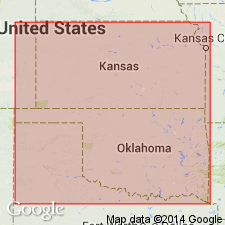
- Usage in publication:
-
- Hartford limestone
- Modifications:
-
- Original reference
- Dominant lithology:
-
- Limestone
- AAPG geologic province:
-
- Forest City basin
Summary:
Pg. 80. Hartford limestone. Limestone, which passes under river at Hartford. Separated from underlying Strawn limestone by 60 feet of sandy shale and from overlying Wyckoff limestone by 50 feet of shale. Age is Pennsylvanian. Report includes cross section.
Named from exposures at Hartford, Lyon Co., eastern KS. Present in Lyon and Coffey Cos., eastern KS.
Source: US geologic names lexicon (USGS Bull. 896, p. 917); supplemental information from GNU records (USGS DDS-6; Denver GNULEX).

- Usage in publication:
-
- Hartford limestone
- Modifications:
-
- Overview
Summary:
Hartford limestone. Same as Topeka limestone (older and better-established name), according to H. Hinds and F.C. Greene, 1915 (Missouri Bur. Geol. and Mines, v. 13). Age is Late Pennsylvanian (Missouri age).
Source: US geologic names lexicon (USGS Bull. 896, p. 917); GNC KS-NE Pennsylvanian Corr. Chart, sheet 1, Oct. 1936.
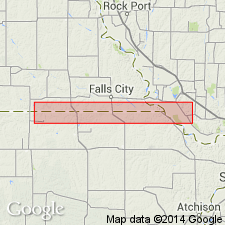
- Usage in publication:
-
- Hartford (Curzon) limestone member
- Modifications:
-
- Revised
Summary:
Hartford (Curzon) limestone member of Topeka limestone formation of Shawnee group. Basal member of Topeka limestone formation, usually consists of 4 or 5 uneven, dark-gray beds separated by shale seams, but in places consists of 2 beds separated by shale. Thickness 6 to 7 feet. Underlies Turner Creek shale member and overlies Iowa Point shale member of Calhoun shale formation. Age is Late Pennsylvanian (Virgil).
Source: US geologic names lexicon (USGS Bull. 896, p. 917, Curzon entry p. 557); GNC KS-NE Pennsylvanian Corr. Chart, sheet 2, Oct. 1936.
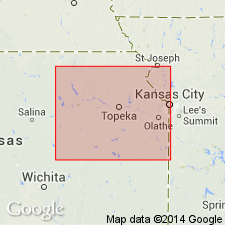
- Usage in publication:
-
- Hartford limestone member
- Modifications:
-
- Contact revised
Summary:
(Sept. 4 to 7, 1936.) Pg. 41. Hartford limestone member of Topeka limestone. Introduced 2 members into Topeka limestone beneath Hartford limestone, as explained under Jones Point shale and Dashner limestone. Age is Late Pennsylvanian (Virgil).
Source: US geologic names lexicon (USGS Bull. 896, p. 917); GNC KS-NE Pennsylvanian Corr. Chart, sheet 2, Oct. 1936.

- Usage in publication:
-
- Hartford limestone member
- Modifications:
-
- Areal extent
- AAPG geologic province:
-
- Forest City basin
Summary:
(Aug. 31, 1936.) Pg. 48, 194-197. Hartford limestone of Kirk is lower member of Topeka limestone as now classified. It consists typically of 1 to 3 or 4 beds (1 to 20 feet thick) of massive or irregularly bedded bluish-gray limestone that weathers brown. Where 2 or more beds of limestone are present they are separated by a shale a few inches to several feet thick. Thickness of member as whole is 1 to 40 feet. Age is Late Pennsylvanian (Virgil).
Well exposed below highway bridge at north edge of Hartford, Coffee [Coffey] Co., eastern KS.
Source: US geologic names lexicon (USGS Bull. 896, p. 917); GNC KS-NE Pennsylvanian Corr. Chart, sheet 2, Oct. 1936.

- Usage in publication:
-
- Hartford limestone
- Modifications:
-
- Not used
Summary:
Topeka limestone (†Hartford limestone). This name was discarded by the USGS in 1912, because then stated to be same as Topeka limestone. (See "Modern classifications of the Pennsylvanian rocks of eastern Kansas and southeastern Nebraska," compiled by M.G. Wilmarth, Secretary of Committee on Geologic Names, USGS unpub. corr. chart, Oct. 1936, 2 sheets.)
Source: US geologic names lexicon (USGS Bull. 896, p. 917); GNC KS-NE Pennsylvanian Corr. Chart, 2 sheets, Oct. 1936.
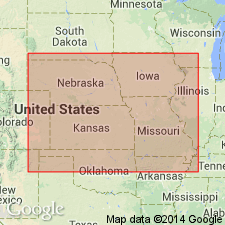
- Usage in publication:
-
- Hartford limestone member*
- Modifications:
-
- Overview
Summary:
Pg. 2035 (fig. 5); 1949, Kansas Geol. Survey Bull., no. 83, p. 142 (fig. 29), 162; F.C. Greene and W.V. Searight, 1949, Missouri Geol. Survey and Water Res. Rpt. Inv., no. 11, p. 18. Hartford limestone member of Topeka formation. Underlies Iowa Point shale member, overlies Calhoun formation. Age is Late Pennsylvanian (Virgilian). This is classification agreed upon by State Geol. Surveys of Iowa, Kansas, Missouri, Nebraska, and Oklahoma, May 1947.
Source: US geologic names lexicon (USGS Bull. 1200, p. 1689-1690).
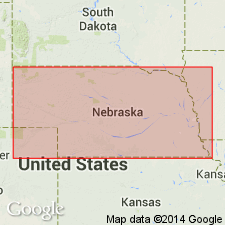
- Usage in publication:
-
- Hartford limestone
- Modifications:
-
- Not used
Summary:
Pg. 21. Condra and Reed (1937, Nebraska Geol. Survey Bull., 2nd ser., no. 11) were uncertain regarding relation of the Hartford of southern Kansas to lower member of the Topeka in northeastern Kansas, southeastern Nebraska, northwestern Missouri, and southwestern Iowa so proposed name Wolf River for basal member of Topeka in this area. Nebraska Survey will drop name Wolf River if it proves to be correlative with the Hartford, which was loosely defined by Kirk (1896) and may have priority if it does not include beds of Du Bois, Iowa Point, and Wolf River age. Type locality stated.
Type locality: where member passes under Neosho River at Hartford, [Coffey] Co., eastern KS. Well exposed north of Hartford.
Source: US geologic names lexicon (USGS Bull. 1200, p. 1689-1690); GNC KS-NE Pennsylvanian Corr. Chart, sheet 2, Oct. 1936.
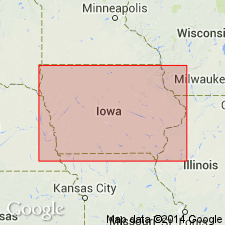
- Usage in publication:
-
- Hartford limestone member
- Modifications:
-
- Areal extent
- AAPG geologic province:
-
- Forest City basin
Summary:
Pg. 16-17, fig. 5. Hartford limestone member of Topeka limestone. Commonly one bed of light- to blue-gray massive limestone; locally contains thin shale bed. Thickness 1 foot near Thurman, Fremont County; 0.5 foot near Howe, Adair County. Basal member of Topeka limestone; underlies Iowa Point shale member; overlies Calhoun shale. Age is Late Pennsylvanian (Virgilian). Called Wolf River in Nebraska.
Source: US geologic names lexicon (USGS Bull. 1200, p. 1689-1690).
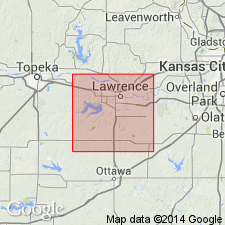
- Usage in publication:
-
- Hartford limestone member
- Modifications:
-
- Areal extent
- AAPG geologic province:
-
- Forest City basin
Summary:
Pl. 1. Hartford limestone member of Topeka limestone. In Douglas County, member is 6 to 8 feet thick and consists of two limestone beds separated by thin shale bed just below middle of member. Underlies Iowa Point Shale member; overlies Calhoun shale. Age is Late Pennsylvanian (Virgilian).
Source: US geologic names lexicon (USGS Bull. 1200, p. 1689-1690).
For more information, please contact Nancy Stamm, Geologic Names Committee Secretary.
Asterisk (*) indicates published by U.S. Geological Survey authors.
"No current usage" (†) implies that a name has been abandoned or has fallen into disuse. Former usage and, if known, replacement name given in parentheses ( ).
Slash (/) indicates name conflicts with nomenclatural guidelines (CSN, 1933; ACSN, 1961, 1970; NACSN, 1983, 2005, 2021). May be explained within brackets ([ ]).

